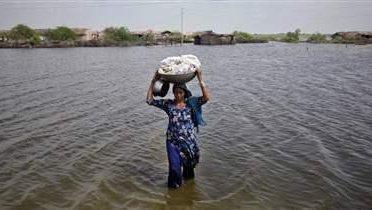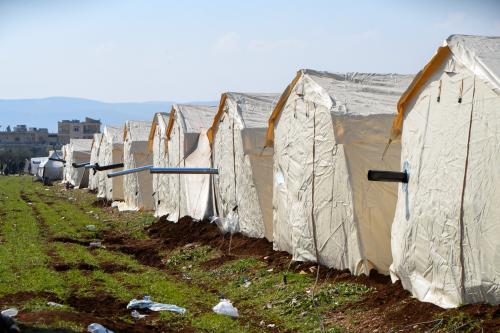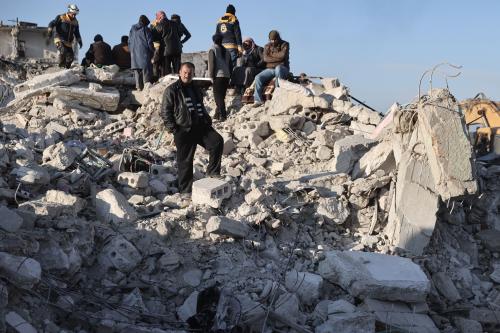Editor’s Note: For Campaign 2012, Bruce Riedel and Michael O’Hanlon wrote a policy brief proposing ideas for the next president on America’s foreign policy toward Afghanistan and Pakistan. The following paper is a response to Riedel and O’Hanlon’s piece from Elizabeth Ferris. Vanda Felbab-Brown also prepared a response arguing that corruption and political patronage in the Afghan government must be overcome to help reconnect the country’s citizens with their government.
As Michael O’Hanlon and Bruce Riedel point out, Afghanistan and Pakistan pose difficult and complex challenges to U.S. security interests—challenges that will need to be addressed by the next president. The next president would also be well-served to direct more attention to the humanitarian needs of Afghans and Pakistanis who suffer the effects of insecurity and conflict. Although often seen as marginal in the great debates over national security and political interests, these humanitarian issues should be a central component of U.S. policy toward both countries. When civilians are killed and people are displaced from their communities, political legitimacy, security and stability are all more difficult to achieve.
Today, both Afghans and Pakistanis face mounting insecurity and increasing displacement. In both countries, the insecure environment constrains the ability to provide needed assistance, as do insufficient funding and the perception that international relief workers are operating in support of Western foreign policy interests. In both countries, humanitarian workers have been targeted by militant groups, and their access to communities in need has diminished.
In the case of Afghanistan, O’Hanlon and Riedel acknowledge differences between NATO and UN estimates of civilian casualties—with NATO reporting fewer enemy-initiated attacks in 2011 compared to 2010, while the UN reports that the number of civilian casualties has increased every year since 2007.[1] It’s fair to say that, for humanitarian actors working on the ground in Afghanistan, there have been few signs of progress in much of the country—a country in which most people have direct, personal and painful experiences of conflict. According to a 2009 survey by the International Committee of the Red Cross (ICRC), 96 percent of Afghans have been directly or indirectly affected by either the immediate or wider consequences of war; nearly half (45 percent) of those interviewed had seen a family member killed; and a third (35 percent) had been wounded in fighting.[2]
Civilian casualties are one measure of insecurity, but another important indicator is displacement. When people feel threatened and insecure, they abandon their homes and flee their communities. Displaced people generally require assistance from their governments or from international agencies. Displacement figures in Afghanistan have increased substantially in the past year. Conflict of various types led to the estimated internal displacement of some 162,000 people between January and October 2011—a 51 percent increase over the same period in 2010. In addition to the half million people displaced by conflict, Afghans also have been displaced by drought across much of the country’s northern and western regions.[3]
Displacement in Afghanistan has a long history, with millions of Afghans having experienced life in refugee camps in neighboring countries. Since 2002, almost 6 million Afghan refugees have returned to the country, mainly from Pakistan and Iran. While these return movements have increased the estimated population of Afghanistan by more than 20 percent, the rate has slowed dramatically, and many of the returnees have been unable to return to their communities of origin and have become internally displaced persons (IDPs).
Humanitarian action in Afghanistan has long been complicated by the counterinsurgency efforts of military forces. Humanitarian workers are intimidated, threatened and sometimes killed, as evidenced by the attacks on staff of the United Nations High Commissioner for Refugees in October 2011. As U.S. forces draw down, there is a danger that the American president’s attention will diminish and that funding for humanitarian response and longer-term governance and development programs will decrease. This would be a mistake. As the UN Secretary General points out, “the long-term challenges of balancing the economic dimensions of the security transition within the broader Kabul Process must be linked to the delivery of real and tangible improvements in the lives of ordinary Afghan citizens.”[4]
Internal displacement is a complex phenomenon in most countries but is particularly so in Pakistan, as a result of the combination of long-standing conflicts in different parts of the country and devastating natural disasters. Nineteen million people have been displaced by earthquakes and flooding over the past five years, along with five million by armed conflict—a combined figure representing an astonishing 13 percent of Pakistan’s population. While most of Pakistan’s displaced have reportedly returned home or settled elsewhere, new conflict-related displacements occurred in 2011 in the Kurram and Khyber Agencies of the Federally Administered Tribal Areas region, and in a number of other locations.
Recurrent conflicts between militant groups and Pakistan’s armed forces have displaced people since at least 2004. Government operations against militants in South Waziristan, the Swat valley and North West Frontier Province in 2008-09 led to the displacement of at least 2 million people in the span of a few weeks—the largest population movement in the country since the 1947 partition. In fact, by 2009, Pakistan had the sixth largest conflict-induced IDP population in the world. Yet, humanitarian agencies’ access to needy people has been difficult in Pakistan, largely because of government restrictions. The government has blocked humanitarian access to IDPs, prior to 2009, for example, in Waziristan and Balochistan. In addition, it expelled the ICRC from the Swat district in July 2009, in part because the organization, in keeping with its principles of independence and neutrality, insisted on conducting its own assessments independently.
Making matters worse, in mid-2010 Pakistan was struck by intense, prolonged monsoon rains of a type unprecedented in the country’s history. The heavy rainfall and resulting floods affected 20 million people (one-tenth of the country’s population) in an area larger than the United Kingdom. In August 2011, the country was still recovering when, once again, major floods affected more than five million people.
There are troubling indications that support for humanitarian assistance to Pakistan is diminishing. In 2009, 71 percent of the resources requested by the UN were forthcoming, but donations following the 2010 floods were insufficient, and in 2011, only 41 per cent of the required amount was funded by the end of the year. As a consequence of funding shortages, food distribution and other vital support has halted, and less than half of the flood-affected population received assistance in 2011.[5]
Developing and sustaining effective humanitarian assistance programs to Afghanistan and Pakistan is a complex and difficult undertaking. But, it must be an important component of any comprehensive U.S. strategy toward these two countries and should thus be a priority for the next president.
[1] UNAMI/OHCHR, Afghanistan: Annual Report 2011. Protection of Civilians in Armed Conflict. February 2012. http://reliefweb.int/node/474741
[2] ICRC/IPSOS, Our World, Views from the Field, Afghanistan Opinion Survey, Geneva, 2009.
[3] Report of the Secretary-General on the Situation in Afghanistan and its Implications for Peace and Security, 13 December 2011, A/66/604–S/2011/772
[4] Ibid.
[5] UN Office for the Coordination of Humanitarian Affairs, 9 December 2011, Monsoon 2011 Situation Report No. 15.



